Abstract
Oil content and the movability of shale oil are important indicators for the evaluation of continental shale oil. In recent years, the sandwiched shale oil in the fourth member of the Shahejie Formation in the Liaohe Western Depression area of the Bohai Bay Basin has shown great exploration potential, while the understanding of shale oil content and the movability of shale oil is weak. In this study, through a combination of core observations and experiments, we clarified the shale lithofacies types in the fourth member of the Shahejie Formation in the Liaohe Western Depression and explored the influencing factors of the characteristics in the oil-bearing and movability of shales in different lithofacies. The results of the study show that the organic matter content of the shale is high (TOC = 2.2–4.3%), but the maturity of thermal evolution is low (Ro = 0.38–0.55%), and the mineral component is dominated by clay minerals (30.3–72.7%), with quartz, feldspar, and other feldspar minerals developing secondarily. According to the content of organic matter, the mineral component, and the sedimentary structure, five types of lithofacies can be classified: organic-rich laminated clay-bearing felsic shale lithofacies (LS1), organic-rich laminated clay felsic mixed shale lithofacies (LS2), organic-rich layered clay felsic mixed shale lithofacies (LS3), organic-containing massive felsic-bearing clay shale lithofacies (LS4), and organic-containing massive clay felsic mixed shale lithofacies (LS5). The oil content of shale is mainly affected by the organic matter. The rate of increase in oil content of shale is fastest when the organic matter content is between 2 and 4%. The movability of shale oil is mainly controlled by the sedimentary structure, mineral component, and microscopic pore structure; the more the shale laminae is developed, the lower the clay content is, and the more the pore space is developed, the better the movability of shale oil is. Combined with the results of the shale oil content and mobility analysis in the study area, LS2 and LS3 are the dominant lithofacies in the fourth member of the Shahejie Formation in the study area, followed by LS1 >LS5 >LS4, so shale oil exploration should focus on the development of LS2 and LS3.
1. Introduction
China’s continental shale oil resources are abundant and widely distributed, and important breakthroughs have been made in the exploration and development of several sets of continental lake basin oil and gas-bearing formations, such as the Permian (Luchaogou Formation and Fengcheng Formation) in the Junggar Basin, the Triassic Yanchang Formation in the Ordos Basin, the Cretaceous Qingshangkou Formation in the Songliao Basin, the Paleoproterozoic Shaxiangjie Formation in the Bohai Basin, and the Jurassic Duanzhai section in the Sichuan Basin, showing that China’s continental shale oil has a good prospect for exploration [1,2,3]. Compared with marine shale, continental shale is non-homogeneous, with features such as rapid sedimentary phase change, frequent intercalation interactions, diverse mineral components, low organic matter evolution, and high viscosity and density of hydrocarbon fluids [4], which is not conducive to determining the dominant shale oil phase zone. Therefore, clarifying the characterization methods of shale oil content and movability and their influencing factors are of great theoretical and practical significance for continental shale oil exploration and development [5,6,7].
In recent years, many scholars have carried out a large number of studies around the oil content and mobility of shale, and its characterization method has been a hot spot of research. Shale oil content characterization methods mainly include Rock-Eval pyrolysis, solvent extraction, and physical simulation to measure oil saturation [8,9]. In Rock-Eval pyrolysis, due to the loss of light hydrocarbons at room temperature and during the experimental process [10], the S1 obtained cannot reflect the content of the heavy part of the oil, and the chloroform asphalt “A” obtained by the extraction method does not reflect the content of C14 hydrocarbons, and both of them have low observational values, which cannot be used as a criterion for the direct characterization of shale oil in the free and adsorbed states Based on digital core, nuclear magnetic resonance (NMR), and well logging data and other means, the oil saturation of the core is measured by establishing an oil saturation model and selecting preferred parameters, and the oil saturation measured by this method has a high accuracy; however, due to the complexity of the analytical process and the strong heterogeneity of continental shale, it does not have a good universality [11]. Regarding the movable shale oil, there are various methods to characterize the movable shale oil [12], and the traditional Rock-Eval pyrolysis S1 and extraction methods are able to achieve the separation of the soluble organic matter of different fugitive states to a certain degree, but the loss of light hydrocarbons during the experimental process leads to the reduction of the movable oil volume [13]. The multi-temperature step pyrolysis method obtains S1-1 light oil and S1-2 light–medium oil based on experiments, and the sum of S1-1 and S1-2 characterizes the amount of movable oil in shale, but the method is mainly used for shale samples of high maturity and is not suitable for measuring samples of low maturity [14]. According to Jarvie et al., the oil saturation index (OSI=S1/TOC) characterization of shale oil movability is effective, and many scholars have agreed with this [15,16], but there is uncertainty in the judgement criteria for different regions. The NMR method is an important method to obtain movable oil saturation due to the non-destructive and rapid experimental process and is often used in quantitative characterization of the movable oil volume. The T2cutoff value calibration method, area difference subtraction method, and so on [17], with the characteristics of small measurement error and high precision, show better research prospects. On the basis of shale oil content and movability characterization methods, it is of great significance to clarify the influencing factors for shale reservoir evaluation in the study area.
The results of previous studies show that the influencing factors of shale oil content include organic carbon content, the development degree of pore seams, the sedimentary structure, and other aspects. Among them, organic carbon content is the key factor affecting the oil content of shale; With similar maturity levels, the higher the organic matter, the better the oil content in the same shale lithofacies [18]. Oil content increases significantly with the increase in pore volume, and the pore-seam system for shale oil transport provides a good storage space and channel, which is conducive to the flow of petroleum and storage [19]. Sedimentary structures are usually developed in semi-deep–deep lake environments where sedimentary waters are quiet, organic matter enrichment is strong, hydrocarbon potential is high, and shale is oil-bearing [20,21]. It was previously believed that shale oil movability is mainly controlled by several factors, such as the sedimentary structure, mineral components, and microscopic pore structure. Laminar development provides a large number of microfractures, resulting in low resistance when oil and gas flow along the direction of the laminar joints, and thus, the movability of shale oil becomes better [22]. Clay minerals have an important limiting effect on the movability of shale oil; due to the strong adsorption capacity of clay minerals, the increase in clay mineral content is conducive to adsorption of state shale oil endowment, which results in shale mobility becoming poorer [23]. Macropores provide a passageway for the shale oil seepage, and the porosity connectivity is better, which is conducive to shale oil seepage, while the small pore size has a certain adsorption effect on shale oil, with strong binding capacity, leading to the deterioration of the movability of shale oil [24]. Therefore, an in-depth study of shale oil content and mobility is of great significance to enrich the theory of continental shale oil exploration in China.
In recent years, many scholars have carried out a large number of studies on the sedimentary characteristics, reservoir characteristics, reservoir conditions, and hydrocarbon resource evaluation of the Shahejie Formation in the Liaohe Western Depression of the Bohai Bay Basin [25,26]. The previous studies were mainly focused on the spreading characteristics of the sandstone segments of the reservoir, but there were fewer studies on the characteristics of the shale reservoirs, and especially, there is a lack of understanding of the oil content and mobility of shale and the factors involved. Therefore, we took the fourth member of the Shahejie Formation in the Liaohe Western Depression of the Bohai Bay Basin as the research object and carried out shale lithofacies delineation according to the mineral components, sedimentary structure, and organic carbon content by combining core observation, experimental analysis test, and geological analysis, which revealed the differences in the oil-bearing and mobility of the different shale lithofacies and defined the oil-bearing and movability characteristics of the shale. We also clarify the influencing factors of shale oil content and movability, providing reference for the selection of development layers and prediction of favorable exploration zones for continental shale oil in the Liaohe Western Depression.
2. Geological Setting
The Liaohe Depression is located in the northeastern part of the Bohai Bay Basin, and the study area is located in the Liaohe Western Depression, which is a long, narrow, north-east spreading mini-shape. The characteristics are high and narrow in the north, low and wide in the south, slow in the west, and steep in the east (Figure 1a). The Paleocene system of the Liaohe Western Depression consists of the Shahejie Formation and the Dongying Formation from the bottom up, and the Shahejie Formation is segmented into the first member, the second member, the third member, and the fourth member of the Shahejie Formation [27] (Figure 1b). The lithological characteristics of the fourth member of the Shahejie Formation are dominated by dark, thick-bedded shales interbedded with thin-bedded sandstones and dolomitic shales, and the cumulative thickness of the shales ranges from 68 to 80.2 m, with a generally thick distribution in the northeast and thin in the southwest [28]. The types of sedimentary facies are mainly lake sedimentary facies and fan delta sedimentary facies.
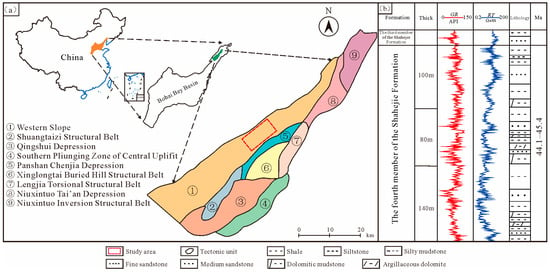
Figure 1.
(a) Location of the Liaohe Western Depression, Baohai Bay Basin in China; (b) comprehensive histogram of the fourth member of Shahejie Formation [29].
3. Samples and Experimental Methods
3.1. Samples
The shale core samples in this study were all from the fourth member of Shahejie Formation in the Liaohe Western Depression of Bohai Bay Basin, distributed in four depth points of 2584 m, 2717.16 m, 2968.06 m, and 3101.63 m, the depth section of 3561.87–3568.17 m, with a total of 18 samples. Some routine experiments were carried out on the samples (including TOC analysis, Rock-Eval pyrolysis, Vitrinoplast reflectance measurements, X-ray diffraction, thin-section observation, FE-SEM, and so on), and the specific experimental methods were referred to the results of previous studies [30]. Nitrogen adsorption experiments, nuclear magnetic resonance experiments, and high-pressure mercury pressure experiments were carried out for the quantitative characterization of pore structure.
3.2. Low-Temperature (77.35 K) Nitrogen Adsorption (N2GA)
Experiments were carried out using ASAP2460 fully automated gas adsorption instrument to measure the experimental results, and the tests were carried out in accordance with GB/T 19587-2017, “Determination of Specific Surface Area of Solid Substances by Gas Adsorption BET Method” [31]. The samples were firstly ground to 20–50 mesh, and organic fluids were extracted from the samples using a solution of acetone and dichloromethane (1:3), and then the samples were heated in a vacuum oven at 60 °C for 12 h. During the experiments, liquid nitrogen with a purity greater than 99.99% was used as the adsorption medium, and the pressure was increased to reach saturation vapor pressure of the liquid nitrogen at the temperature of liquid nitrogen (77.35 K). Then, the pressure was gradually decreased. The adsorption–desorption curve of nitrogen was obtained by measuring the adsorption amount of the gas when the relative pressure was gradually increased and the desorption amount when the pressure was decreased. The adsorption–desorption curves of nitrogen can be used to obtain the BJH pore volume, average pore diameter, and BET specific surface area of the samples.
3.3. High-Pressure Mercury Intrusion (HPMI)
Experiments used the U.S. AutoPore IV9500 mercuric pressure instrument in Daqing city to measure the experimental results, the test implementing the standards GB/T 29172-2012 “Practices for core analysis” [32] and GB/T 29171-2012 “Rock capollary pressure measurement” [33]. Before the experimental test, the sample shape was firstly made into a cubic sample (length × width × height = 1.2 × 1.2 × 1.2 cm3), which was dried to constant weight at 105 °C and then tested in the extraction and heating state (the treatment was the same as that of conducting the N2GA) to obtain the amount of mercury fed into the sample, the amount of mercury withdrawn from the sample, and the various experimental parameters of high-pressure mercury pressure under different pressures, including porosity, average pore diameter, pore volume, mercury withdrawal efficiency, etc. The highest experimental pressure did not exceed 200 MPa.
3.4. Nuclear Magnetic Resonance (NMR)
Experiments were carried out using GeoSpec2 NMR core analyzer produced by Resonance Instruments of the UK in Daqing city, China, and the tests were conducted in accordance with China’s petroleum and natural gas industry standard SY/T 6490-2014, “Specification for Laboratory Measurement of NMR Parameters of Rock Samples” [34]. The test procedure is to extract the samples by organic solvent and vacuum heating to remove the water in the samples, then measure the T2 signal of the dry samples and weigh them; the extracted dry samples are saturated with n-dodecane for 24 h, and the saturated samples are measured and weighed after full saturation. The samples are then centrifuged with centrifugal force of 2.916 MPa (centrifugal rotational speed of 9000 r/min), and centrifugal samples are measured and weighed after centrifugal samples are centrifuged for 1 h. The basic parameters of this experiment are 35 °C, 2 MHz, 0.2 ms echo interval, 6 s waiting time, 4096 echoes, and 32 scans.
4. Results
4.1. Organic Geochemical Characterization
According to the analysis of the 18 shale samples, the results show that the minimum value of TOC is 0.46%, and the maximum value is 7.04%; the minimum value of S1 is 0.07 mg/g, and the maximum value is 4.34 mg/g; while the minimum value of chloroform asphalt “A” is 0.02%, and the maximum value is 1.04%. The values of S1, chloroform asphalt “A”, and TOC have a similar trend (Table 1). When the TOC < 2%, the growth rate is slower, when the TOC is between 2 and 4%, the growth rate is obviously faster, and when the TOC > 4%, the growth rate gradually slows down (Figure 2). Ro is considered a better index to discriminate the maturity of OM. It is difficult to measure the value of Ro, because the shale samples have a lot of algae and lack of vitrinite in the study area. The samples are basically in a hydrogen-rich environment (algae fluorescence is strong, most of the vitrinite are also weakly fluorescent), the maturity of hydrogen-rich vitrinite is inhibited, and the measurement value of vitrinite will be suppressed to a certain extent and become lower [35,36]. The minimum value of Ro was measured as 0.37%, the maximum value was 0.68%, the maturity of the thermal evolution was relatively low, and the hydrocarbon generation threshold for shale oil was basically reached [37].

Table 1.
The TOC, S1, S2, “A”, and Ro of shale samples.
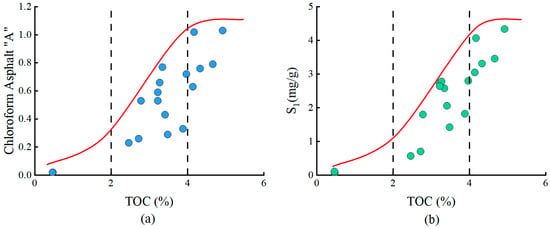
Figure 2.
(a) The relationship between TOC and content of chloroform asphalt “A”; (b) the relationship between TOC and content of S1.
4.2. Characteristics of Mineral Components
Quantitative analysis of whole-rock minerals using whole-rock mineral X-diffraction experiments on shale samples from the fourth member of the Shahejie Formation in the Liaohe Western Depression (Figure 3). The results show that the mineral components of shale are dominated by clay minerals, with a content of 30.3–72.7%; quartz, feldspars, and other feldspathic minerals are developed secondly, with a content of 17.2–62.7%. The carbonate mineral contents are lower, mainly calcite and pyrite, with contents of 1–22.8%; some samples contain other minerals such as square zeolite, barite, and hornblende, with contents of 0.3–6.8%; meanwhile, the pyrite content is 0.4–5%. The content of major minerals (e.g., quartz, clay, and calcite) varies in different shale samples, reflecting the strong non-homogeneity of continental shale.
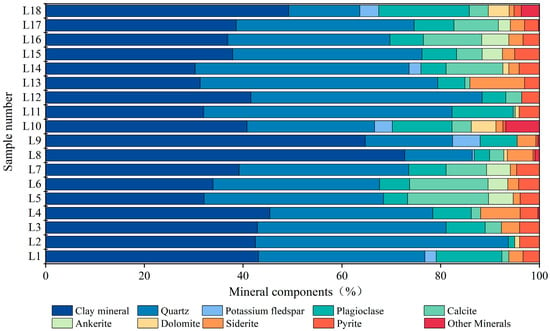
Figure 3.
The variety of mineral composition in the fourth member of the Shahejie Formation.
4.3. Characteristics of Reservoir Space
4.3.1. Type of Reservoir Space
Scholars at home and abroad have proposed different division schemes for the development characteristics of pore throats in continental shale reservoirs, in which they are divided into intragranular pore, intercrystalline pore, organic matter pore, and micro-fracture according to the characteristics of the mineral structure, the composition of organic matter, diagenesis, and so on [38]. In this paper, we analyze the cores and thin sections of the fourth member of the Shahejie Formation, and with scanning electron microscope analysis, the shale reservoir space type of the fourth member of Shahejie Formation in the study area is classified into five types: intergranular pore, intercrystalline pore, dissolution pore, organic matter pore, and micro-fracture. Intergranular pores are the main types of pores in the shale of the fourth member of the Shahejie Formation in the study area, which are mostly formed by secondary intergranular pores of quartz and other brittle minerals after compaction and crushing. There are fewer primary intergranular pores, and the pore cross-section is mainly in the form of slit, wedge, or irregular (Figure 4a,b). Intercrystalline pores are formed by the inter-support of different mineral crystals [3]. There are mainly pyrite intercrystalline pores, dolomite intercrystalline pores are less-developed, and the pore morphology is mainly in the form of strawberry-shaped pyrite microsphere aggregate and irregular polygonal shape, which is often filled by organic matter (Figure 4c,d). The formation of the dissolution pores is related to the organic acid produced in the process of hydrocarbon production of organic matter and mainly develops two types of intragranular dissolution pores in the feldspar and intragranular dissolution pores in the dolomite grains, and the pore morphology is round or elliptic (Figure 4e). The organic matter pores are formed through the generation and expulsion of hydrocarbons, but the degree of thermal evolution and the development of organic matter pores are low, the pore morphology is mainly elliptical or irregular polygonal, and the honeycomb morphology is not seen (Figure 4f). The micro-fractures are more developed in the sand section but also can be seen in structural joints, interlayer joints, and laminated joints, with the width of the joints up to micrometers, and the common organic matter fills them (Figure 4g–i).

Figure 4.
Types of reservoir space in the fourth member of the Shahejie Formation. (a) Broken intragranular pore; (b) intragranular pores of feldspar; (c) intercrystalline pores filled with organic matter; (d) intercrystalline pores of pyrite; (e) dissolution pores in feldspar particles; (f) organic matter contraction seam; (g) microstructural fracture; (h) interlayer fracture filled with organic matter; (i) inter-laminar fracture filled with organic matter.
4.3.2. Pore Structure Characterization
- (1)
- Nitrogen adsorption experiment and high-pressure mercury injection experiment parameters.
Sample pore size-related parameters were obtained based on the BET model and the BJH model (Table 2), in which the BET specific surface area was distributed in the range of 6.7976 m2/g~42.2139 m2/g, with an average value of 15.1883 m2/g; the BJH pore volume was distributed in the range of 0.0122 cm3/g~0.0404 cm3/g, with an average value of 0.0221 cm3/g; and the average pore size distribution of BJH was 5.5876 nm~12.7806 nm, with an average value of 7.2447 nm.

Table 2.
The table of N2 adsorption experimental parameters of samples.
The high-pressure mercury injection experiment is commonly used for the quantitative characterization of a reservoir’s microporous structure, and the relevant pore structure parameters obtained from the experiment have different indicative significance. In the present study, the average pore throat radius is used to characterize the size of the pore throat, the coefficient of variation is used to characterize the degree of pore throat sorting, and the expulsion pressure is used to characterize the connectivity of the pore throat. The results of the high-pressure mercury compression experiments (Table 3) show that the average pore diameter was distributed in the range of 0.009–0.026 μm, with an average value of 0.014 μm; the coefficient of variation was distributed in the range of 0.096–0.174, with an average value of 0.149; and the expulsion pressure was distributed in the range of 5.481–18.656 Mpa, with an average value of 12.603 Mpa.

Table 3.
The table of mercury intrusion pore structure parameters of samples.
- (2)
- Nuclear magnetic resonance experiment.
Ten shale samples from the fourth member of the Shahejie Formation in the study area were selected to carry out NMR experiments, and the NMR T2 spectra were plotted by the transverse relaxation time T2 with the signal intensity of each sample in the saturated and centrifuged state. The saturated sample T2 spectral characteristics of shale samples from the fourth member of Shahejie Formation were analyzed, and according to the number of peaks in the T2 spectra, the T2 spectra were classified into the three categories of single-peak type, double-peak type, and multiple-peak type (Figure 5). The single-peak pore type T2 spectrum distribution shows that the mesopores of small pores are more developed, and the pore throat radius is medium, which can be seen in the L7 sample. The double-peak pore type T2 spectrum distribution shows that the macropores and mesopores are more developed, and the pore throat radius is large, which can be seen in the L1–L6 and L8 samples. The multi-peak pore type T2 spectrum distribution shows that the small pores are more developed, the mesopores and macropores are less developed, and the pore throat radius is small. At the same time, with the increase in the T2 relaxation time, the saturated T2 spectrum is divided into three types of samples. With the increase in T2 relaxation time, the signal intensity of the saturated samples suddenly increases and then decreases, indicating that cracks may exist, as seen in samples L9 and L10.
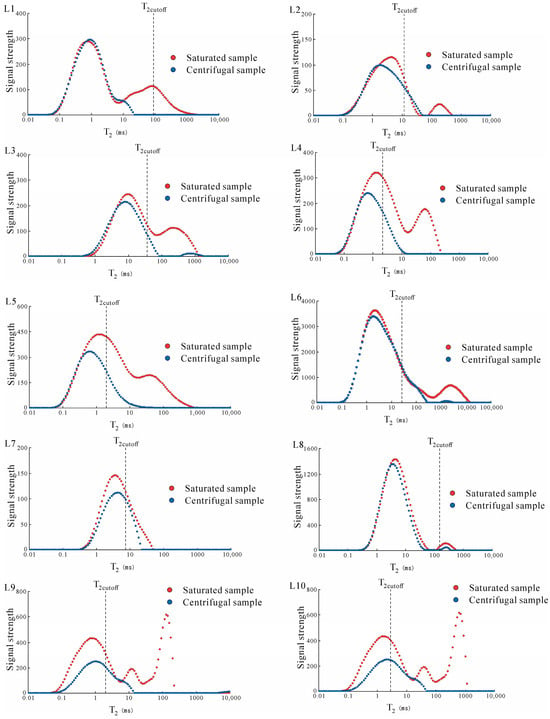
Figure 5.
NMR T2 spectrum of different samples (centrifugal sample, saturated sample).
5. Discussion
5.1. Lithofacies Classification of Shale
5.1.1. Principles and Bases for Classification of Lithofacies Types
Lithofacies refers to the rocks or rock assemblages formed in a certain depositional environment, which is a synthesis of rock types and sedimentary structures and is an important indicator for evaluating shale oil enrichment. At present, scholars at home and abroad have carried out a lot of research on the delineation of continental shale facies [39], but due to the strong non-homogeneity of continental shale, the understanding of different regions is different, and it is difficult to form a set of unified delineation schemes. In order to clarify the type of lithofacies in the study area, it is found by comparing the experimental data of each core sample that lithology, sedimentary structure, and organic matter abundance are the influencing factors for the lithofacies of various types of shale in the fourth member of the study area. Therefore, in this study, referring to the lithofacies delineation standards of continental shale proposed by previous researchers [40,41] and combining them with the actual situation of the study area, the lithofacies of continental shale in the fourth member of the study area are delineated based on the consideration of three main factors: organic matter content, mineral components, and sedimentary structure. Firstly, two-level rock naming zoning was carried out by using the three-terminal meta-diagrams of felsic minerals (quartz + feldspar), carbonate minerals (calcite + siderite + dolomite + ankerite), and clay minerals content. With 50% as the boundary to determine the main name of the rock, four primary lithofacies zones were divided; then, 25% of the mineral content was used as the boundary for secondary zoning, and the four lithofacies of the primary zones were subdivided into 12 lithofacies of the secondary zones, of which if none of the minerals exceeded 50%, the name was designated as a mixed lithofacies phase. Secondly, in order to reflect the difference in the degree of enrichment of organic matter in different types of shale, 2% of the TOC content was used as a demarcation line between the organic matter-containing and organic-rich phases and was used as a lithofacies name. Finally, Finally, the sedimentary structure is divided into laminated (laminae thickness < 1 mm), layered (laminae thickness 1–10 mm), and blocky (laminae thickness is not developed), to give the lithofacies classification a clearer significance as an environmental indicator (Figure 6).
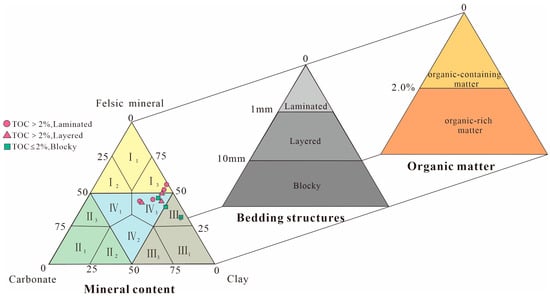
Figure 6.
The lithofacies division of the fourth member of the Shahejie Formation in the Liaohe Western Depression, Baohai Bay Basin (revised by [42]): I1—felsic shale, I2—carbonate-bearing felsic shale, I3—clay-bearing felsic shale, II1—carbonate shale, II2—clay-bearing carbonate shale, II3—felsic-bearing carbonate shale, III1—clay shale, III2—felsic-bearing clay shale, III3—carbonate-bearing clay shale, IV1—felsic carbonate mixed shale, IV2—carbonate clay mixed shale, IV3—felsic clay mixed shale.
5.1.2. Basic Characteristics of the Main Lithofacies Shale
On the basis of clarifying the shale facies classification criteria, the continental shale facies types in the fourth member of the Liaohe Western Depression were classified into five types by drawing triangular diagrams, and the characteristics of each type of facies are as follows (Figure 7). Organic-rich laminated clay-bearing felsic shale lithofacies (LS1): the TOC is >2%, the content of felsic minerals is >50%, the content of clay minerals is between 25% and 50%, and the content of carbonate is <25%. According to the observation of the thin section, it is found that the laminae are more developed, and under the scanning electron microscope, it is observed that the rock is more dense, the porosity is dominated by intragranular pores and intercrystalline pores, the pyrite is more developed, it is in the shape of berry globule, it is rich in organic matter, and Organic matter is mostly filled between mineral grains. Organic-rich laminated clay felsic mixed shale lithofacies (LS2): the TOC is >2%, the content of felsic and clay mineral is 25–50%, and the content of carbonate mineral is <25%. According to the observation of the thin section, it was found that the laminae were developed, the asphalt was distributed in the form of lines to fill the cracks, and the pore space was relatively dense with intergranular pores, mainly formed by the dissolution of feldspar and carbonate rock minerals. The scanning electron microscope observed that the rock was relatively dense, the pores were mainly intergranular, the dissolution pores were mainly formed by feldspar and carbonate minerals, it was rich in organic matter, and a large number of organic matter fillings were seen between the particles. Organic-rich layered clay felsic mixed shale lithofacies (LS3): the TOC is >2%, the content of felsic and clay mineral is 25–50%, the content of carbonate mineral is <25%, and the laminae are more developed. The scanning electron microscope observed that the rock is relatively dense, the pores are dominated by intergranular pores and intercrystalline pores, there is a large quantity of berry spherical pyrite, and there is common organic matter filled with mineral grains. Organic-containing massive felsic-bearing clay shale lithofacies (LS4): the TOC is <2%, the content of felsic mineral is 25–50%, the content of clay minerals is >25%, and the content of carbonate mineral is <25%. According to the thin-section observation, it was found that the laminae were not developed and some organic matter was developed. Under the scanning electron microscope, it was observed that the rock was denser and the pores were more developed, the pores were dominated by intergranular pores and intercrystalline pores, and organic matter was common in the fillings. Organic-containing massive clay felsic mixed shale lithofacies (LS5): the TOC is <2%, the content of felsic and clay mineral is 25–50%, and the content of carbonate mineral is <25%. According to the thin-section observation, it was found that mud crystal dolomite and asphalt can be seen and the laminae are not developed. Under the scanning electron microscope, it was observed that the structure of the rock was denser, the intergranular pores were more developed and most of them were in the form of slit, and, at the same time, the rock was obviously affected by the compaction.
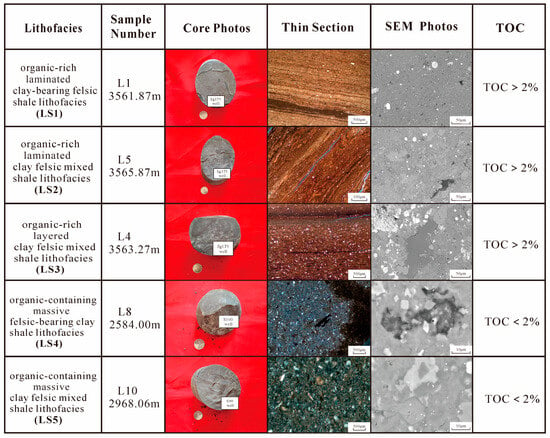
Figure 7.
The lithofacies features of typical samples (core, thin section, SEM).
5.2. Oil Content of Shale
5.2.1. Hydrocarbon Occurrence
The oil content correlation is crucial for the comprehensive evaluation of oil in continental shale, and the difference in oil content between different shale phases is mainly affected by organic matter content and pore structure [43]. Therefore, this study comprehensively evaluates the oil content of shale from both qualitative and quantitative aspects.
Shale oil has various occurrence states, including free state, adsorbed state, and dissolved state, mainly in the shale pores and cracks [44]. In the fourth member of Shahejie Formation in the study area, the shale oil is mainly in the free state and adsorbed state, in which the free shale oil is mainly in the inorganic mineral pores and microfractures of the shale matrix, such as the intergranular pores of chalk particles and the intergranular pores of dolomite crystals (Figure 8a,b); the adsorbed shale oil is mainly on the surface of the clay minerals, the strawberry-like pyrite binding body, and the adsorption in the pore surfaces of the organic matter (Figure 8c,d).
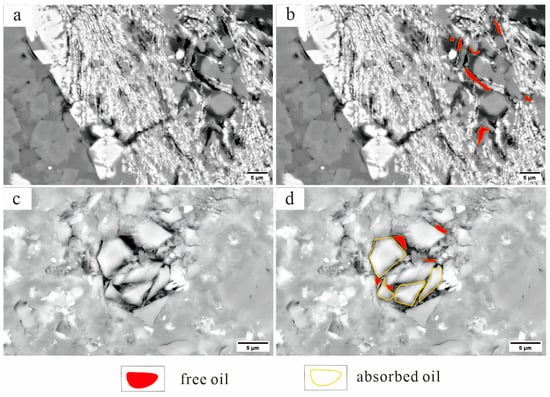
Figure 8.
Images of microscopic occurrence of shale oil. (a,b) Intergranular pores of pyrite, 3566.87 m; (c,d) intergranular pores of quartz particles, 2968.06 m.
The incremental pore volume (dV/dD) measured by nitrogen adsorption experiments was used to reflect the pore size range of shale oil. Comparison of the experimental data before and after oil washing shows that the pore size changes are mainly concentrated in the interval of 2~100 nm, in which the pore size changes are more obvious when the pore size is from 2 nm to 5 nm. The pore size distribution curve is in the shape of multiple peaks (Figure 9), which indicates that movable oils are mainly endowed in the mesopores with smaller pore sizes.

Figure 9.
Nitrogen adsorption pore size distribution (as received, extraction).
5.2.2. Characterization of Shale Oil Content
Oil content is an important index for evaluating shale oil resource potential. S1 is an experimental parameter commonly used to characterize the oil content of shale. However, the cores in the fourth member of the Shahejie Formation in this study have been shelved for a long time, so the light and heavy hydrocarbons of each sample tend to dissipate to a certain extent, resulting in the experimental measurement of S1 being low. Recently, S1 measured based on experiments was not able to accurately characterize the oil content of the samples in their original state [45]. In order to carry out the recovery of S1 for the pyrolysis parameter, the following expression was applied (Equation (1)):
S1′ is the pyrolysis parameter of recovered light hydrocarbons, mg/g; C1 is the recovery coefficient of light hydrocarbons for the pyrolysis parameter; and C2 is the recovery coefficient of heavy hydrocarbons for the pyrolysis parameter.
Since the organic geochemical characteristics of the fourth member of the Shahejie Formation in the Dongying Depression and the Liaohe Western Depression are similar, the organic matter types are both of type II1 and the Ro in the study area is 0.37–0.68%. The recovery coefficients of light and heavy hydrocarbons are sought on the basis of the previous study [46], where C1 is taken to be 0.1, and C2 is taken to be 0.3. It can be seen by the recovery of S1 that organic-rich layered clay felsic mixed shale lithofacies (LS3) has the best oil content, with S1′ taking the range of 5.55–7.29 mg/g and an average value of 6.34 mg/g; organic-rich laminated clay felsic mixed shale lithofacies (LS2) has better oil content, with S1′ taking the range of 5.36–5.50 mg/g and an average value of 4.18 mg/g; the organic-rich laminated clay-bearing felsic shale lithofacies (LS1) has medium oil content, with S1′ values ranging from 3.64–4.25 mg/g and an average value of 3.95 mg/g; organic-containing massive felsic-bearing clay shale lithofacies (LS4) has poor oil content, with S1′ values ranging from 0.18–1.79 mg/g and an average value of 0.99 mg/g; and organic-containing massive clay felsic mixed shale lithofacies (LS5) has the worst oil content, with S1′ averaging 0.23 mg/g.
5.2.3. Factors Influencing the Oil Content of Shale
The oil content of shale is an important index for the evaluation of shale oil’s resource potential, so establishing the relationship between each geological parameter and oil content as well as analyzing the influence of different geological factors on the oil content of shale in the fourth member of Shahejie Formation will be conducive to the fine prediction of the geological evaluation in the subsequent study area.
Organic matter content is the main influence factor of shale oil content, organic matter is the basis of shale oil enrichment, and high organic matter content is conducive to shale oil generation in large quantities. Through the establishment of the relationship between TOC and shale oil content, it can be found that the oil content of shale with different lithofacies shows a good positive correlation with TOC; with the increase of TOC content, the S1′ content also increases (Figure 10). Combined with the previous analysis, when TOC < 2%, the chloroform asphalt “A” S1′ content and the growth rate is slow; fewer hydrocarbons are generated by the organic matter at this stage, which cannot satisfy the adsorption needs of shale itself; and the lithofacies types are mainly LS4 and LS5. When 2% < TOC < 4%, the S1′ content is in the stage of rapid growth, which indicates that a large number of free hydrocarbons have been generated by the organic matter at this stage, and the lithological types are mainly LS1 and LS2. When TOC > 4%, due to thermal maturation and hydrocarbon discharge, the hydrocarbon production reaches saturation [47]; all the liquid hydrocarbons generated are free oil; the corresponding S1′ content growth rate slows down; and the lithofacies type is LS3. Regarding differences in the oil content of different lithofacies, in terms of sedimentary structure, the blocky shale (LS4, LS5) is the worst, the laminated shale (LS1, LS2) is medium, and the layered shale (LS3) is the best.
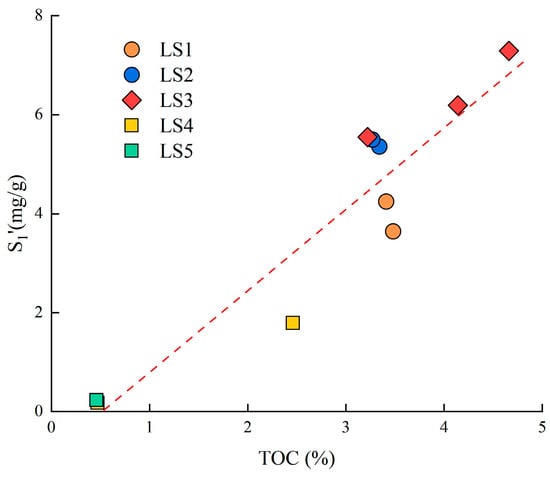
Figure 10.
Relationship between TOC and S1′.
5.3. Shale Oil Movability
5.3.1. Shale Oil Movability Characterization
Mobility is another important indicator for evaluating shale oil resource potential. The mobility characteristics of shale oil are of great significance for exploration and development. Currently, NMR experiments are commonly used to calculate the movable oil volume, and methods include the T2cutoff value method and area difference subtraction method. These methods are used to characterize the movability of shale oil with small measurement error and high accuracy [48].
The T2cutoff method is to calculate the total signal amplitude of the NMR T2 spectra before and after signal strength, respectively, and find a point on the T2 spectrum before signal strength so that the total amplitude of the T2 spectra at the points to the left of that point is equal to the total amplitude of the T2 spectrum after signal strength; the T2 value corresponding to that point is the T2cutoff (Figure 11a). When the relaxation time is greater than T2cutoff, it is considered as movable oil and vice versa for bound oil [49] (Figure 11b). Therefore, the proportion of movable oil is expressed through the ratio of movable oil volume to saturated oil volume (Equation (2)).

Figure 11.
(a) NMR T2cutoff value calibration; (b) NMR-based T2cutoff method; (c) area subtraction method.
U1 is the movable oil ratio, %; T2min and T2max are the T2 minimum and T2 maximum values, ms, respectively; T2cuttoff is the T2cutoff value, ms; and S(T2) is the expression of the T2 spectral distribution curve.
The area subtraction method uses the difference between the pre-centrifugation T2 spectral peak area minus the post-centrifugation T2 spectral peak area. The ratio of this difference to the saturated sample T2 spectral peak area is the movable oil ratio (Figure 11c) ((Equation (3)):
U2 is the proportion of movable oil, %; S0 is the T2 spectral area of the saturated sample; and S1 is the T2 spectral area of the centrifuged sample.
In order to obtain more accurate results and avoid experimental chance, the movability of shale oil was jointly characterized by the NMR T2cutoff and area difference subtraction methods in this study (Table 4). According to the T2cutoff method, the movable oil proportion obtained was from 2.5% to 39.59%, with an average value of 19.5%, and the movable oil proportion obtained from the area difference subtraction method was from 7.91% to 38.62%, with an average value of 20.02%; the average value of the two methods was taken for the joint characterization of shale movable oil proportion. The results show that LS2 has the highest percentage of movable oil, which is 30.65%, followed by LS3 with 23.05%, LS5 with 18.06%, LS1 with 12.65%, and LS4 with 10.36%. Combined with the results of shale oil-bearing and movability experiments, organic-rich laminated clay felsic mixed shale lithofacies (LS2) and organic-rich layered clay felsic mixed shale lithofacies (LS3) have the best oil-bearing and movability and are the best types of lithofacies in the fourth member of the Shahejie Formation in the study area.

Table 4.
Movable oil ratio in different shale lithofacies.
5.3.2. Factors Affecting Shale Movability
According to previous researchers, the movability of shale oil is mainly affected by sedimentary structure, mineral components, and reservoir microscopic pore structure. The influencing factors of the movability of shale oil are discussed by analyzing the relationship between movable oil ratio and sedimentary structure, mineral component content, and pore structure parameters.
- (1)
- Sedimentary structure
Sedimentary structure is the main factor governing the movability of shale oil. From the previous conclusions, it is clear that the movability of shale oil in textured shale is better than that of laminated and massive shale. The development of textured layers leads to the transport of fluids within the rock along the direction of microfractures between the layers, and the microfractures distributed between the layers are more likely to form a complex fracture network, which increases the transverse permeability of the reservoir and the fluid diffusion paths and contributes to the enhancement of the movability of shale oil [50]. However, not all shales’ laminated formations have better movability than layered formations. The movability of organic-rich laminated clay-bearing felsic shale lithofacies (LS1) is weaker than that of organic-rich layered clay felsic mixed shale lithofacies (LS3), and the presence of more laminar joints in the LS3 samples leads to the enhancement of shale oil seepage capacity, which results in a better movability. Organic-rich laminated clay-bearing felsic shale lithofacies (LS1) and organic-rich laminated clay felsic mixed shale lithofacies (LS2) are both laminar shales, but the proportion of movable oil in LS2 is significantly higher than that in LS1, with the high number of laminae developed and the better lateral circulation within the rock due to the more developed cracks, which results in the high movability of shale oil (Figure 12). Therefore, the development of laminae can effectively improve the pore connectivity, which is conducive to increasing the movability of shale oil.
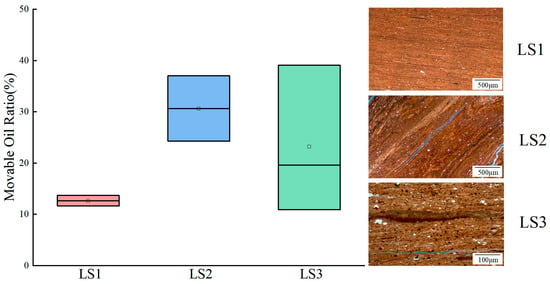
Figure 12.
Relationship between LS1, LS2, and LS3 slice observation photos and movable oil ratio.
- (2)
- Mineral components
We establish the relationship between clay minerals, felsic minerals, and the proportion of movable oil, and it is found that the proportion of movable oil in the shale has a weak negative correlation trend with the content of clay minerals and a weak positive correlation trend with the content of felsic minerals (Figure 13). According to the results of whole-rock mineral X-ray diffraction experiments, the clay mineral content of LS2 is significantly smaller than that of LS1, because the clay minerals in the fourth member of the Shahejie Formation are dominated by illite and smectite/illite mixed layers in the form of flakes and filaments, and illite has a strong adsorption capacity for shale oil. Some intragranular pores and dissolution pores are usually developed in the smectite/illite mixed layers, which will improve the adsorption capacity of clay minerals to a certain extent [51]. Similarity, the large specific surface area of clay minerals will lead to the enhancement of the interaction between the pore throat surface and the fluid, which increases the volume of oil adsorbed on the pore wall [52]. Therefore, with the increase in clay mineral content, it is not conducive to the flow of shale oil, resulting in a decrease in the content of movable oil. Quartz and feldspar of felsic minerals are hydrophilic [53] and have a weak adsorption capacity for shale oil, which is conducive to the flow of shale oil. At the same time, when the brittle mineral content is high, it is easy to produce natural fractures, which plays a certain role in promoting the flow of shale oil. It can also be seen from Figure 13 that LS1, LS2, and LS3 are all organic-rich shales, and their mineral composition has a weak correlation with the movability of shale oil. In conclusion, the mineral composition of the fourth member of the study area has no obvious effect on the movability of shale oil. The effect of mineral components’ content on the movability of shale oil is low in the fourth member of Shahejie Formation in the study area.
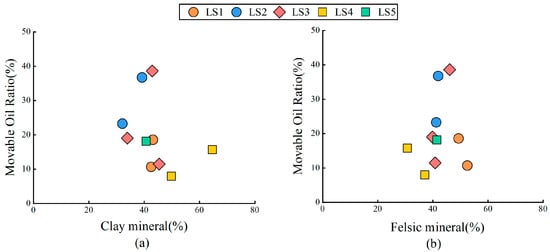
Figure 13.
(a) Relationship between clay minerals and movable oil ratio; (b) relationship between felsic minerals and movable oil ratio.
- (3)
- Microscopic pore structure
The occurrence of microscopic pores has been investigated in the fourth member of the Shahejie Formation. The influence of microscopic pore structures on the movability of shale oil was analyzed in combination with the experimental parameters of nitrogen adsorption and high-pressure mercury pressure. In the parameters of the nitrogen adsorption experimental results, we found that the proportion of movable oil had a negative correlation trend with the specific surface area and pore volume (Figure 14a,b), and the proportion of movable oil had no correlation with the average pore diameter (Figure 14c). Due to the small pores of the fourth member of the Shahejie Formation in the study area, mainly developing micropores and mesopores with smaller pore sizes. The small pore provides the main specific surface area and pore volume, and a large specific surface area will have a certain impediment to the storage and transport of hydrocarbons [54], which is not conducive to the seepage of the shale oil, so the proportion of movable oil decreases with increase in the specific surface area. In the high-pressure mercury pressure experiment results parameters, we found that the average pore throat radius and the coefficient of variation are positively correlated with the proportion of movable oil (Figure 15a,b), and there is no significant correlation between the displacement pressure and the proportion of movable oil (Figure 15c). The size of reservoir pore throats affects its seepage capacity, and the size of pore throats is characterized by the average pore throat radius. The larger the average pore throat radius, the better the connectivity between pore throats, the stronger the seepage capacity, and the better the movability of shale oil. The pore throat sorting characteristics are characterized by the coefficient of variation; the larger the coefficient of variation, the worse the sorting of pore throats, the more the large pore space is developed, and the better the movability of shale oil. Pore throat sorting characteristics are characterized by the coefficient of variation, and the larger the coefficient of variation, the worse the sorting of the pore throat, the more developed the macropores, and the better the movability of shale oil. In summary, the smaller the specific surface area and pore volume, the larger the average pore throat radius; and the larger the coefficient of variation, the better the movability of shale oil, and the conforming petrographic types include LS2 and LS3.

Figure 14.
(a) Relationship between surface area and movable oil ratio; (b) relationship between pore volume and movable oil ratio; (c) relationship between average pore size and movable oil ratio.

Figure 15.
(a) Relationship between surface area and movable oil ratio; (b) relationship between pore volume and movable oil ratio; (c) relationship between average pore size and movable oil ratio.
6. Conclusions
A detailed study of the oil-bearing nature of shale and the movability of shale oil in the fourth member of the Shahejie Formation in the Liaohe Western Depression has been carried out, which is summarized as follows:
- (1)
- The fourth member of the Shahejie Formation in the Liaohe Western Depression mainly develops a set of lake sedimentary phases and fan delta sedimentary phases, and the shale phases are mainly divided into five categories based on organic carbon content, mineral components, and lithofacies types, including organic-rich laminated clay-bearing felsic shale lithofacies (LS1), organic-rich laminated clay felsic mixed shale lithofacies (LS2), organic-rich layered clay felsic mixed shale lithofacies (LS3), organic-containing massive felsic-bearing clay shale lithofacies (LS4), and organic-containing massive clay felsic mixed shale lithofacies (LS5).
- (2)
- Organic-rich layered clay felsic mixed shale lithofacies (LS3) has the best oil content, and the average value of S1′ is 6.34 mg/g. The organic-rich laminated clay felsic mixed shale lithofacies (LS2) has the strongest movability, and the percentage of movable oil is 30.65%. TOC is the main influencing factor on the oil content of shale, and with the increase in TOC content, the oil content of the shale increases. The movability of shale oil is controlled by the sedimentary structure, mineral components, and microscopic pore structure; the more developed the shale laminae, the less clay content, and the more developed the large pores, the better the movability of shale oil.
- (3)
- It is clear that the organic-rich laminated clay felsic mixed shale lithofacies (LS2) and organic-rich layered clay felsic mixed shale lithofacies (LS3) are the dominant lithofacies in the fourth member of Shahejie Formation of the Liaohe Western Depression. In the process of the subsequent exploration and development, the dominant shale should be selected with the characteristics of a higher number of grains, a TOC of >2%, a mixed texture of clay minerals and felsic minerals ranging from 25% to 50%, and a higher degree of development of micro-fractures.
Author Contributions
Conceptualization, L.Z. and S.X.; methodology, L.Z. and X.Z.; validation, L.Z. and S.X.; formal analysis, K.J. and C.C.; investigation, Y.L.; resources, Y.L. and J.L.; data curation, R.L. and M.L.; writing—original draft preparation, S.X.; writing—review and editing, L.Z. and S.X.; visualization, S.X.; supervision, S.X. and L.Z.; funding acquisition, L.Z. and X.Z. All authors have read and agreed to the published version of the manuscript.
Funding
This research was funded by the Chongqing Talent Plan “Contract System” Project (cstc2024ycjh-bgzxm0064), the Chongqing Natural Science Foundation (cstc2021hcyj-msxmX0984) and the Science and Technology Research Project of Chongqing Education Commission (No. KJZD-K202401503).
Data Availability Statement
The original contributions presented in the study are included in the article, further inquiries can be directed to the corresponding author.
Conflicts of Interest
The authors declare no conflicts of interest.
References
- Zou, C.N.; Yang, Z.; Cui, J.W.; Zhu, R.K.; Hou, L.H.; Tao, S.Z.; Yuan, X.J.; Wu, S.T.; Lin, S.H.; Wang, L.; et al. Formation mechanism, geological characteristics and development countermeasures of shale oil. Pet. Explor. Dev. 2013, 40, 14–26. [Google Scholar] [CrossRef]
- Zhao, W.Z.; Jia, A.L.; Wei, Y.S.; Wang, J.L.; Zhu, H.Q. Progress and prospect of shale gas exploration and development in China. China Pet. Explor. 2020, 25, 31–44. [Google Scholar]
- Guo, X.S.; Ma, X.X.; Li, M.W.; Qian, M.H.; Hu, Z.Q. Discussion on enrichment mechanism of continental shale oil. Oil Gas Geol. 2023, 44, 1333–1349. [Google Scholar]
- Liu, H.M.; Bao, Y.S.; Zhang, S.C.; Li, Z.; Li, J.L.; Wang, X.J.; Wu, L.B.; Wang, Y.; Wang, W.Q.; Zhu, R.F.; et al. Structural characteristics and shale oil mobility of continental carbonate-rich shale: A case study of Paleogene Shahejie Formation shale in Jiyang Depression. Pet. Explor. Dev. 2023, 50, 1150–1161. [Google Scholar] [CrossRef]
- Zhao, W.Z.; Hu, S.Y.; Hou, L.H.; Yang, T.; Li, X.; Guo, C.B.; Yang, Z. Types, resource potential and boundary with tight oil of continental shale oil in China. Pet. Explor. Dev. 2020, 47, 1–10. [Google Scholar] [CrossRef]
- Jin, Z.J.; Wang, G.P.; Liu, G.X.; Gao, B.; Liu, Q.Y.; Wang, H.L.; Liang, X.P.; Wang, R.Y. Research progress and key scientific issues of continental shale oil in China. Acta Pet. Sin. 2021, 42, 821–835. [Google Scholar]
- Lu, S.F.; Xue, H.T.; Wang, M.; Xiao, D.S.; Huang, W.B.; Li, J.Q.; Xie, L.J.; Tian, S.S.; Wang, S.; Li, J.J.; et al. Some key issues and research trends in shale oil evaluation. Acta Pet. Sin. 2016, 37, 1309–1322. [Google Scholar]
- Romero-Sarmiento, M.F. A quick analytical approach to estimate both free versus sorbed hydrocarbon contents in liquid-rich source rocks. AAPG Bull. 2019, 103, 2031–2043. [Google Scholar] [CrossRef]
- Lu, S.F.; Huang, W.B.; Chen, F.W.; Li, J.J.; Wang, M.; Xue, H.T.; Wang, W.M.; Cai, X.Y. Some key issues in shale oil evaluation and research trends Discussion on classification evaluation criteria of shale oil and gas resources. Pet. Explor. Dev. 2012, 39, 249–256. [Google Scholar] [CrossRef]
- Li, M.; Wang, M.; Zhao, C.; Zhang, J.Y.; Liu, Z.; Zhao, X.B.; Li, J.B.; Chen, J.Y. Compositional differences of near-critical petroleum from closed pores to wellhead in Gulong shale oil play, Songliao Basin, NE China. Mar. Pet. Geol. 2024, 167, 106968. [Google Scholar] [CrossRef]
- Liu, W.; Zhang, D.F.; Liu, H.H.; Zhang, W.J. Application of digital core technology in oil saturation evaluation of tight sandstone reservoir. Fault-Block Oil Gas Field 2013, 20, 593–596. [Google Scholar]
- Zhu, X.M.; Zhu, W.B.; Cao, J.; Song, Y.; Zhang, D.M.; Hu, S.Z.; Li, S.F. Research progress on characterization methods of shale oil mobility. Xinjiang Pet. Geol. 2019, 40, 745–753. [Google Scholar]
- Song, G.Q.; Zhang, L.H.; Lu, S.F.; Xu, X.Y.; Zhu, R.F.; Wang, M.; Li, Z. Shale oil resource evaluation technology and its application. Earth Sci. Front. 2013, 20, 221–228. [Google Scholar]
- Cang, J.Q.; Jiang, Z.X.; Gao, Z.Y.; Zheng, G.W.; Zhang, Y.H.; Huang, L.L.; He, W.J.; Duan, L.F.; Chen, Z.X.; Song, J.N. Oil-bearing and mobility characteristics of different lithofacies shales in Fengcheng Formation of Mahu Sag. J. Cent. South Univ. (Sci. Technol.) 2022, 53, 3354–3367. [Google Scholar]
- Behar, F.; Beaumont, V.; Penteado, H.L. Rock-Eval 6 Technology. Performances and Development. Oil Gas Sci. Technol. 2001, 56, 111–134. [Google Scholar] [CrossRef]
- Jiang, Z.X.; Li, T.W.; Gong, H.J.; Jiang, T.; Chang, J.Q.; Ning, C.X.; Su, S.Y.; Chen, W.T. Characteristics of low-mature shale reservoirs in Zhanhua Sag and their influence on shale oil mobility. Acta Pet. Sin. 2020, 41, 1587–1600. [Google Scholar]
- Jiang, Q.G.; Li, M.W.; Qian, M.H.; Li, Z.M.; Li, Z.; Huang, Z.K.; Zhang, C.M.; Ma, Y.Y. Quantitative characterization of shale oil in different occurrence states and its application. Pet. Geol. Exp. 2016, 38, 842–849. [Google Scholar]
- Xu, C.Y.; Xie, R.H.; Guo, J.F.; Jin, G.W.; Fan, W.S.; Xiao, L.Z. Comprehensive characterization of petrophysical properties in shale by solvent extraction experiments and 2D NMR. Fuel 2023, 335, 127070. [Google Scholar] [CrossRef]
- Song, Y.Q.; Kausik, R. NMR application in unconventional shale reservoirs-A new porous media research frontier. Prog. Nucl. Magn. Reson. Spectrosc. 2019, 112/113, 17–33. [Google Scholar] [CrossRef]
- Ma, Y.S.; Cai, X.Y.; Zhao, P.R.; Hu, Z.Q.; Liu, H.M.; Gao, B.; Wang, W.Q.; Li, Z.M.; Zhang, Z.L. Geological characteristics and exploration practice of continental shale oil in China. Acta Geol. Sin. 2022, 96, 155–171. [Google Scholar]
- Jiang, F.J.; Hu, M.L.; Hu, T.; LYU, J.H.; Huang, L.L.; Liu, C.L.; Jiang, Z.X.; Huang, R.D.; Zhang, C.X.; Wu, G.Y.; et al. Controlling factors and models of shale oil enrichment in Lower Permian Fengcheng Formation, Mahu Sag, Junggar Basin, NW China. Pet. Explor. Dev. 2023, 50, 812–825. [Google Scholar] [CrossRef]
- Liu, G.H.; Huang, Z.L.; Jiang, Z.X.; Chen, J.F.; Chen, C.C.; Gao, X.Y. Development characteristics and reservoir significance of laminae in lacustrine shale of Yanchang Formation in Ordos Basin. Nat. Gas Geosci. 2015, 26, 408–417. [Google Scholar]
- Chai, B.Q.; Zhao, F.; Ji, Y.B.; Chen, L.; Cheng, Q.S. Lithofacies Types and Reservoir Characteristics of Mountain Shale in Wufeng Formation-Member 1 of Longmaxi Formation in the Complex Structural Area of Northern Yunnan–Guizhou. ACS Omega 2023, 8, 2085–2097. [Google Scholar] [CrossRef] [PubMed]
- Wang, S.; Feng, Q.H.; Farzam, J.; Xia, T.; Li, Z. Oil adsorption in shale nanopores and its effect on recoverable oil-in-place. Int. J. Coal Geol. 2015, 147, 9–24. [Google Scholar] [CrossRef]
- Lu, S.F.; Chen, G.H.; Wang, M.; Li, J.B.; Wang, X.; Shan, J.F.; Hu, Y.J.; Mao, J.L. Evaluation of resource potential of shale oil enrichment in the fourth member of Shahejie Formation in Damintun Sag, Liaohe Depression. Oil Gas Geol. 2016, 37, 8–14. [Google Scholar]
- Li, X.G. Heavy oil accumulation conditions and key technologies of exploration and development in Huanxiling Oilfield of Liaohe Depression. Acta Pet. Sin. 2021, 42, 541–560. [Google Scholar] [CrossRef]
- Li, Y.; Li, X.G.; Zhang, T.S.; Zhou, B.F.; Chen, C.; Li, J.P.; Zhou, X.L.; Wang, G.F.; Liu, Y.; Qi, X.C.; et al. Astronomical cycle identification of fine-grained rock and its application in fine stratigraphic division: A case study of the fourth member of Shahejie Formation in Leijia area, western sag of Liaohe Basin. Acta Sedimentol. Sin. 2024, 1–19. [Google Scholar] [CrossRef]
- Wang, X.B.; Jiang, Z.X.; Hu, G.Y.; Fan, T.N.; Wang, J.H.; Lu, H. Sedimentary facies and evolution of upper Es4 of Paleogene in western sag of Liaohe Basin. J. Jilin Univ. (Earth Sci. Ed.) 2019, 49, 1222–1234. [Google Scholar]
- Liu, Y.L.; Zhang, L.; Zhang, X.J.; He, X.; Li, J.P.; Xing, Y.B.; Jin, F.X.; Wang, Y.R. Pore Structure and Fractal Characteristics of Continental Low Maturity Organic-Rich Shale in the Sha-4 Member of the Liaohe Western Depression. Energies 2022, 16, 327. [Google Scholar] [CrossRef]
- Wang, X.; Wang, M.; Zhao, C.; Yang, X.Y.; Jia, Y.D.; Wu, R.; Li, T.Y.; Zhao, X.B.; Tang, Y.L. Reservoir characteristics and controlling factors of the middle–high maturity multiple lithofacies reservoirs of the Lianggaoshan Formation shale strata in the northeastern Sichuan basin, China. Mar. Pet. Geol. 2024, 161, 106692. [Google Scholar] [CrossRef]
- GB/T 19587−2017; Determination of the Specific Surface Area of Solids by Gas Adsorption Using the BET Method. Standards Press of China: Beijing, China, 2017.
- GB/T 29172-2012; Practices for Core Analysis. Standards Press of China: Beijing, China, 2017.
- GB/T 29171-2012; Rock Capollary Pressure Measurement. Standards Press of China: Beijing, China, 2012.
- SY/T 6490-2014; Specification for Measurement of Rock NMR Parameter in Laboratory. Petroleum Industry Press: Beijing, China, 2015.
- Wenger, L.M.; Baker, D.R. Variations in vitrinite reflectance with organic facies—Examples from Pennsylvanian cyclothems of the midcontinent, USA. Org. Geochem. 1987, 11, 411–416. [Google Scholar] [CrossRef]
- Wilkins, R.W.T.; Wilmshurst, J.R.; Russell, N.J.; Hladky, G.; Ellacott, M.V.; Buckingham, C. Fluorescence alteration and the suppression of vitrinite reflectance. Org. Geochem. 1992, 18, 629–640. [Google Scholar] [CrossRef]
- Li, X.G.; Liu, X.Z.; Li, J.P.; Tian, Z. Comprehensive evaluation and exploration practice of lacustrine shale oil in the fourth member of Shahejie Formation in Damintun Sag, Liaohe Depression. China Pet. Explor. 2019, 24, 636–648. [Google Scholar]
- Zhu, R.K.; Bai, B.; Cui, J.W.; Wu, S.T.; Cui, J.G.; Wang, T.; Niu, L.; Li, T.T. Research progress on microstructure of unconventional oil and gas tight reservoirs. J. Palaeogeogr. 2013, 15, 615–623. [Google Scholar]
- Li, M.W.; Ma, X.X.; Jin, Z.J.; Li, Z.M.; Jiang, Q.G.; Wu, S.Q.; Li, Z.; Xu, Z.X. The diversity of lithofacies assemblages of marine and continental shale strata in China and its significance for unconventional oil and gas exploration. Oil Gas Geol. 2022, 43, 1–25. [Google Scholar]
- Ma, C.F.; Liu, S.P.; Zhao, Q.; Fan, Y.J.; Qian, Y.Y.; Liu, X.T.; Ge, X.M. Sedimentary Genesis and Model Analysis of Shale Lithofacies in Jiyang Depression. Processes 2023, 11, 2302. [Google Scholar] [CrossRef]
- Bian, C.S.; Guo, B.C.; Pu, X.; Zeng, X.; Liu, W.; Li, Y.X.; Zhou, K.J.; Tian, Q.H.; Ma, C. Lithofacies Characteristics and Their Effects on Shale Oil Enrichment: A Case Study from Shahejie Formation of the Qibei Sag, Bohai Bay Basin, China. Energies 2023, 16, 2107. [Google Scholar] [CrossRef]
- Jarvie, D.M. Shale resource systems for oil and gas: Part 2. Shale-oil resource systems. In Shale Reservoirs: Giant Resources for 21st Century; Breyet, J., Ed.; AAPG Memoir; AAPG: Houston, TX, USA, 2012; pp. 89–119. [Google Scholar]
- Wang, Y.; Wang, X.J.; Song, G.Q.; Liu, H.M.; Zhu, D.S.; Zhu, D.Y.; Ding, J.H.; Yang, W.Q.; Yin, Y.; Zhang, S.; et al. Relationship between shale lithofacies and shale oil enrichment in Jiyang Depression, Bohai Bay Basin. Pet. Explor. Dev. 2016, 43, 696–704. [Google Scholar] [CrossRef]
- Wang, M.; Ma, R.; Li, J.B.; Lu, S.F.; Li, C.M.; Guo, Z.Q.; Li, Z. Occurrence mechanism of lacustrine shale oil in Shahejie Formation of Paleogene in Jiyang depression. Pet. Explor. Dev. 2019, 46, 789–802. [Google Scholar] [CrossRef]
- Wang, M.; Li, M.; Li, J.B.; Xu, L.; Shao, H.M.; Yu, C.Q.; Li, T.T. Comparison of various test methods for shale oil content. Acta Pet. Sin. 2022, 43, 1758–1769. [Google Scholar]
- Zhu, R.F.; Zhang, L.H.; Li, J.Y.; Liu, Q.; Li, Z.; Wang, R.; Zhang, L. Quantitative evaluation of retained liquid hydrocarbon in shale. Acta Pet. Sin. 2015, 36, 13–18. [Google Scholar]
- Cao, X.X.; Meng, X.Z.; Pu, R.H. Understanding of movable fluid occurrence characteristics based on fractal theory of pore throat system in tight sandstone reservoir. Nat. Gas Ind. 2023, 43, 78–90. [Google Scholar]
- Yuan, X.T.; Peng, S.M.; Lin, C.Y.; Jia, R.G. An interpretation method for permeability based on flow units and its applicability. Acta Pet. Sin. 2005, 26, 78–81. [Google Scholar]
- Zeng, W.Z.; Song, Z.G.; Cao, X.X. Oil-bearing analysis of source rocks in Qingshankou Formation in northern Songliao Basin. Geochimica 2018, 47, 345–353. [Google Scholar]
- Mao, J.L.; Zhang, J.C.; Liu, T.; Ding, J.H. Shale lamina structure and its reservoir space significance in western sag of Liaohe. Pet. Geol. Exp. 2019, 41, 113–120. [Google Scholar]
- Xie, J.Y.; Yuan, Z.Z.; Dai, B.; Wu, C.M.; Jia, C.; Xu, F.; Luo, Q.; Cui, Q. Shale oil reservoir bedding fracture imbibition mechanism and imbibition mode. Spec. Oil Gas Reserv. 2021, 28, 161–167. [Google Scholar]
- Huang, X.; Li, T.T.; Wang, X.Z.; Gao, H.; Ni, J.; Zhao, J.X.; Wang, C. Distribution characteristics and influencing factors of movable fluid in tight sandstone reservoir-Taking Chang 8 reservoir group of Yanchang Formation in Jiyuan Oilfield of Ordos Basin as an example. Acta Pet. Sin. 2019, 40, 557–567. [Google Scholar]
- Gao, Z.Y.; Fan, Y.P.; Hu, Q.H.; Jiang, Z.X.; Cheng, Y.; Xuan, Q.X. A review of shale wettability characterization using spontaneous imbibition experiments A review of shale wettability characterization using spontaneous imbibition experiments. Mar. Pet. Geol. 2019, 109, 330–338. [Google Scholar] [CrossRef]
- Yang, C.; Zhang, J.C.; Li, W.J.; Jing, T.Y.; Sui, R.; Wang, Z.P.; He, W.; Lu, Y.Y. Microscopic pore characteristics and reservoir-forming significance of shale in Es3 and Es4 of Liaohe Depression. Oil Gas Geol. 2014, 35, 286–294. [Google Scholar]
Disclaimer/Publisher’s Note: The statements, opinions and data contained in all publications are solely those of the individual author(s) and contributor(s) and not of MDPI and/or the editor(s). MDPI and/or the editor(s) disclaim responsibility for any injury to people or property resulting from any ideas, methods, instructions or products referred to in the content. |
© 2024 by the authors. Licensee MDPI, Basel, Switzerland. This article is an open access article distributed under the terms and conditions of the Creative Commons Attribution (CC BY) license (https://creativecommons.org/licenses/by/4.0/).